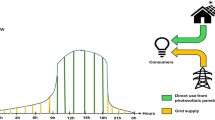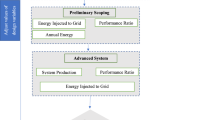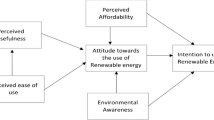Abstract
The environmental benefits of photovoltaic (PV) panels have attracted attention worldwide although they still lack the necessary levels of performance and financial viability. To meet these standards, PV tracking technologies are utilized to maximize the efficiency of PV systems. The principal goal of this research work is to perform a techno-economic feasibility analysis and optimal sizing of renewable energy systems integrated into solar tracking technologies for a rural residential user in South Africa. The vertical axis (VC), dual-axis tracker (DA), horizontal axis with monthly (HM), and continuous (HC) adjustments are the tracking options implemented to determine a profitable energy system. The preferred optimal cases based on these scenarios are introduced, and then sensitivity analysis is carried out to estimate the effect of variation of technical, economic, and climatic parameters. The VC-based system offers a financially desirable alternative having net present cost (NPC), levelized energy cost (LCOE), and CO2 emissions of $13.7k, $0.258/kWh, and 2.81.1 kg/year, respectively. Sensitivity analysis indicates that an increase in SOCmin would raise NPC and CO2 emissions. The DA and VC trackers, respectively, show the greatest and lowest increases in NPC due to diesel prices increase. In VC and HM-based cases, PV generation and the renewable fraction are more sensitive to albedo (ground reflectance) variation. Comparing the current optimal results with the previous research in this location demonstrates that NPC and LCOE can be reduced by implementing a proper controlling strategy by $58k and $0.005/kWh, respectively, to meet the same electrical load.
Access this chapter
Tax calculation will be finalised at checkout
Purchases are for personal use only
Similar content being viewed by others
Abbreviations
- DA:
-
Dual-axis tracker
- DG:
-
Diesel generator
- F1:
-
Fuel curve slope (L/h/ output kW or m3/h/output kW
- Fo:
-
Generator fuel curve intercept co-efficient (L/h/rated kW or m3/h/rated kW)
- fpv:
-
PV derating factor (%)
- FT:
-
Fixed tilt
- GS:
-
Incident radiation at standard test conditions (1 kW/m2)
- GT:
-
Solar radiation incident in the current hour (kW/m2)
- HKT:
-
Hydrokinetic turbine
- HM:
-
Horizontal axis
- HV:
-
Vertical axis
- LCOE:
-
Levelized cost of energy($/kWh)
- Lmax:
-
Absorption width in maximum power
- NPC:
-
Net present cost
- O&M:
-
Operation and maintenance cost
- PDG:
-
Generator output power (kW)
- PDG:
-
Rated generator power (kW)
- Pmax:
-
Maximum available power
- PV:
-
Solar photovoltaic
- Q:
-
Energy available in the storage at the first timestep (kWh)
- Q1:
-
Available energy remained at the first timestep (kWh)
- Wpv:
-
Peak power output of PV array (kW)
- YDG:
-
Rated capacity of the generator (kW)
- ηDG:
-
Generator efficiency (%)
References
J.G. Peña Balderrama et al., Incorporating high-resolution demand and techno-economic optimization to evaluate micro-grids into the Open Source Spatial Electrification Tool (OnSSET). Energy Sustain. Dev. 56, 98–118 (2020). https://doi.org/10.1016/j.esd.2020.02.009
T. Kobayakawa, T.C. Kandpal, A techno-economic optimization of decentralized renewable energy systems: trade-off between financial viability and affordability—a case study of rural India. Energy Sustain. Dev. 23, 92–98 (2014). https://doi.org/10.1016/j.esd.2014.07.007
T. Levin, V.M. Thomas, Can develo** countries leapfrog the centralized electrification paradigm? Energy Sustain. Dev. 31, 97–107 (2016). https://doi.org/10.1016/j.esd.2015.12.005
M. Babaei Jamnani, A. Kardgar, Energy‐exergy performance assessment with optimization guidance for the components of the 396‐MW combined‐cycle power plant. Energy Sci. Eng. 8(10), 3561–3574 (2020). https://doi.org/10.1002/ese3.764
T.S. Costa, M.G. Villalva, Technical evaluation of a PV-diesel hybrid system with energy storage: case study in the Tapajós-Arapiuns extractive reserve, Amazon, Brazil. Energies 13(11), 2969 (2020). https://doi.org/10.3390/en13112969
X. Liu, Q. Tan, Y. Niu, R. Babaei, Techno-economic analysis of solar tracker-based hybrid energy systems in a rural residential building: a case study in South Africa. Int. J. Green Energy 20(2), 192–211 (2023). https://doi.org/10.1080/15435075.2021.2024545
J. Lata-García, F. Jurado, L.M. Fernández-Ramírez, H. Sánchez-Sainz, Optimal hydrokinetic turbine location and techno-economic analysis of a hybrid system based on photovoltaic/hydrokinetic/hydrogen/battery. Energy 159, 611–620 (2018). https://doi.org/10.1016/j.energy.2018.06.183
H.J. Vermaak, Techno-economic analysis of solar tracking systems in South Africa. Energy Procedia 61, 2435–2438 (2014). https://doi.org/10.1016/j.egypro.2014.12.018
K. Kusakana, Optimization of the daily operation of a hydrokinetic–diesel hybrid system with pumped hydro storage. Energy Convers. Manag. 106, 901–910 (2015). https://doi.org/10.1016/j.enconman.2015.10.021
K. Kusakana, Optimal operation scheduling of a hydrokinetic-diesel hybrid system with pumped hydro storage, in 2015 4th International Conference on Electric Power and Energy Conversion Systems (EPECS), (2015), pp. 1–6. https://doi.org/10.1109/EPECS.2015.7368539
M. Shafiey Dehaj, H. Hajabdollahi, Multi-objective optimization of hybrid solar/wind/diesel/battery system for different climates of Iran. Environ. Dev. Sustain. 23(7), 10910–10936 (2021). https://doi.org/10.1007/s10668-020-01094-1
M. Najafi Ashtiani, A. Toopshekan, F. Razi Astaraei, H. Yousefi, A. Maleki, Techno-economic analysis of a grid-connected PV/battery system using the teaching-learning-based optimization algorithm. Sol. Energy 203, 69–82 (2020). https://doi.org/10.1016/j.solener.2020.04.007
S.A. Mousavi, R.A. Zarchi, F.R. Astaraei, R. Ghasempour, F.M. Khaninezhad, Decision-making between renewable energy configurations and grid extension to simultaneously supply electrical power and fresh water in remote villages for five different climate zones. J. Clean. Prod. 279, 123617 (2021). https://doi.org/10.1016/j.jclepro.2020.123617
R. Babaei, D.S. Ting, R. Carriveau, Feasibility and optimal sizing analysis of stand-alone hybrid energy systems coupled with various battery technologies: a case study of Pelee Island. Energy Rep. 8, 4747–4762 (2022). https://doi.org/10.1016/j.egyr.2022.03.133
S. Vendoti, M. Muralidhar, R. Kiranmayi, Techno-economic analysis of off-grid solar/wind/biogas/biomass/fuel cell/battery system for electrification in a cluster of villages by HOMER software. Environ. Dev. Sustain. 23(1), 351–372 (2021). https://doi.org/10.1007/s10668-019-00583-2
A. Shahzad, S. Hanif, Techno-economic feasibility of biogas generation in Attari village, Ferozepur road, Lahore. Environ. Dev. Sustain. 16(5), 977–993 (2014). https://doi.org/10.1007/s10668-013-9506-5
N.R. Deevela, B. Singh, T.C. Kandpal, Techno-economics of solar PV array-based hybrid systems for powering telecom towers. Environ. Dev. Sustain. 23(11), 17003–17029 (2021). https://doi.org/10.1007/s10668-021-01379-z
A.S. Aziz, M.F.N. Tajuddin, M.R. Adzman, M.A.M. Ramli, Impacts of albedo and atmospheric conditions on the efficiency of solar energy: a case study in temperate climate of Choman, Iraq. Environ. Dev. Sustain. 23(1), 989–1018 (2021). https://doi.org/10.1007/s10668-019-00568-1
T. Chen, M. Wang, R. Babaei, M.E. Safa, A.A. Shojaei, Technoeconomic analysis and optimization of hybrid solar-wind-hydrodiesel renewable energy systems using two dispatch strategies. Int. J. Photoenergy 2023 (2023). https://doi.org/10.1155/2023/3101876
A. Amirsoleymani, R. Babaei, S.S. Mousavi Ajarostaghi, M. Saffari Pour, Feasibility evaluation of stand-alone energy solutions in energy-poor Islands using sustainable hydrogen production. Int. J. Energy Res. 46(15), 24045–24063 (2022). https://doi.org/10.1002/er.8704
M.A. Mohamed, H.M. Abdullah, M.A. El-Meligy, M. Sharaf, A.T. Soliman, A. Hajjiah, A novel fuzzy cloud stochastic framework for energy management of renewable microgrids based on maximum deployment of electric vehicles. Int. J. Electr. Power Energy Syst. 129, 106845 (2021). https://doi.org/10.1016/j.ijepes.2021.106845
M.A. Mohamed, T. **, W. Su, Multi-agent energy management of smart islands using primal-dual method of multipliers. Energy 208, 118306 (2020). https://doi.org/10.1016/j.energy.2020.118306
H. Zou, J. Tao, S.K. Elsayed, E.E. Elattar, A. Almalaq, M.A. Mohamed, Stochastic multi-carrier energy management in the smart islands using reinforcement learning and unscented transform. Int. J. Electr. Power Energy Syst. 130, 106988 (2021). https://doi.org/10.1016/j.ijepes.2021.106988
B. Bhandari, K.-T. Lee, C.S. Lee, C.-K. Song, R.K. Maskey, S.-H. Ahn, A novel off-grid hybrid power system comprised of solar photovoltaic, wind, and hydro energy sources. Appl. Energy 133, 236–242 (2014). https://doi.org/10.1016/j.apenergy.2014.07.033
F.K. Abo-Elyousr, A. Elnozahy, Bi-objective economic feasibility of hybrid micro-grid systems with multiple fuel options for islanded areas in Egypt. Renew. Energy 128, 37–56 (2018). https://doi.org/10.1016/j.renene.2018.05.066
M.K. Shahzad, A. Zahid, T. ur Rashid, M.A. Rehan, M. Ali, M. Ahmad, Techno-economic feasibility analysis of a solar-biomass off grid system for the electrification of remote rural areas in Pakistan using HOMER software. Renew. Energy 106, 264–273 (2017). https://doi.org/10.1016/j.renene.2017.01.033
A. Oulis Rousis, D. Tzelepis, I. Konstantelos, C. Booth, G. Strbac, Design of a hybrid AC/DC microgrid using HOMER Pro: case study on an islanded residential application. Inventions 3(3), 55 (2018). https://doi.org/10.3390/inventions3030055
M.H. Jahangir, S.A. Mousavi, R. Asayesh Zarchi, Implementing single- and multi-year sensitivity analyses to propose several feasible solutions for meeting the electricity demand in large-scale tourism sectors applying renewable systems. Environ. Dev. Sustain. 23(10), 14494–14527 (2021). https://doi.org/10.1007/s10668-021-01254-x
H.Z. Al Garni, A. Awasthi, M.A.M. Ramli, Optimal design and analysis of grid-connected photovoltaic under different tracking systems using HOMER. Energy Convers. Manag. 155, 42–57 (2018). https://doi.org/10.1016/j.enconman.2017.10.090
V. Boddapati, A.S.R. Nandikatti, S.A. Daniel, Techno-economic performance assessment and the effect of power evacuation curtailment of a 50 MWp grid-interactive solar power park. Energy Sustain. Dev. 62, 16–28 (2021). https://doi.org/10.1016/j.esd.2021.03.005
R. Srivastava, A.N. Tiwari, V.K. Giri, An overview on performance of PV plants commissioned at different places in the world. Energy Sustain. Dev. 54, 51–59 (2020). https://doi.org/10.1016/j.esd.2019.10.004
M.H.M. Sidek, N. Azis, W.Z.W. Hasan, M.Z.A. Ab Kadir, S. Shafie, M.A.M. Radzi, Automated positioning dual-axis solar tracking system with precision elevation and azimuth angle control. Energy 124, 160–170 (2017). https://doi.org/10.1016/j.energy.2017.02.001
V. Sumathi, R. Jayapragash, A. Bakshi, P. Kumar Akella, Solar tracking methods to maximize PV system output—a review of the methods adopted in recent decade. Renew. Sustain. Energy Rev. 74, 130–138 (2017). https://doi.org/10.1016/j.rser.2017.02.013
S. Sinha, S.S. Chandel, Analysis of fixed tilt and sun tracking photovoltaic–micro wind based hybrid power systems. Energy Convers. Manag. 115, 265–275 (2016). https://doi.org/10.1016/j.enconman.2016.02.056
S. Bhakta, V. Mukherjee, Techno-economic viability analysis of fixed-tilt and two axis tracking stand-alone photovoltaic power system for Indian bio-climatic classification zones. J. Renew. Sustain. Energy 9(1), 015902 (2017). https://doi.org/10.1063/1.4976119
C. Li, W. Yu, Techno-economic comparative analysis of off-grid hybrid photovoltaic/diesel/battery and photovoltaic/battery power systems for a household in Urumqi, China. J. Clean. Prod. 124, 258–265 (2016). https://doi.org/10.1016/j.jclepro.2016.03.002
N.M. Kumar, J. Vishnupriyan, P. Sundaramoorthi, Techno-economic optimization and real-time comparison of sun tracking photovoltaic system for rural healthcare building. J. Renew. Sustain. Energy 11(1), 015301 (2019). https://doi.org/10.1063/1.5065366
H. Al Garni, A. Awasthi, Techno-economic feasibility analysis of a solar PV grid-connected system with different tracking using HOMER software, in 2017 IEEE International Conference on Smart Energy Grid Engineering (SEGE) (2017), pp. 217–222. https://doi.org/10.1109/SEGE.2017.8052801
S. Mubaarak et al., Techno-economic analysis of grid-connected PV and fuel cell hybrid system using different PV tracking techniques. Appl. Sci. 10(23), 8515 (2020). https://doi.org/10.3390/app10238515
X. Liu et al., Techno-economic analysis of solar tracker-based hybrid energy systems in a rural residential building: a case study in South Africa. Int. J. Green Energy 00(00), 1–20 (2022). https://doi.org/10.1080/15435075.2021.2024545
M.R. Elkadeem, S. Wang, S.W. Sharshir, E.G. Atia, Feasibility analysis and techno-economic design of grid-isolated hybrid renewable energy system for electrification of agriculture and irrigation area: a case study in Dongola, Sudan. Energy Convers. Manag. 196, 1453–1478 (2019). https://doi.org/10.1016/j.enconman.2019.06.085
K. Kusakana, Techno-economic analysis of off-grid hydrokinetic-based hybrid energy systems for onshore/remote area in South Africa. Energy 68, 947–957 (2014). https://doi.org/10.1016/j.energy.2014.01.100
Resources, NASA Prediction of Worldwide Energy Resources (2021). https://power.larc.nasa.gov
K. Kusakana, H.J. Vermaak, Hydrokinetic power generation for rural electricity supply: case of South Africa. Renew. Energy 55, 467–473 (2013). https://doi.org/10.1016/j.renene.2012.12.051
R. Babaei, D.S.-K. Ting, R. Carriveau, Feasibility and optimal sizing analysis of stand-alone hybrid energy systems coupled with various battery technologies: a case study of Pelee Island. Energy Rep. 8, 4747–4762 (2022). https://doi.org/10.1016/j.egyr.2022.03.133
1KW 2KW 3KW 5KW Windmill Generator System/2KW 3KW 5KW Wind Turbine Kit, “Alibaba.” https://www.alibaba.com/product-detail/1KW-2KW-3KW-5KW-Windmill-Generator_60493711744.html?spm=a2700.details.0.0.5bce10144u6yxW
¢/KWH Levelized Cost of Electricity for Various Power and Energy Efficiency Options, National Hydropower Association. https://www.hydro.org/waterpower/why-hydro/affordable
C.S. Lai et al., Levelized cost of electricity for photovoltaic/biogas power plant hybrid system with electrical energy storage degradation costs. Energy Convers. Manag. 153, 34–47 (2017). https://doi.org/10.1016/j.enconman.2017.09.076
M.R. Akhtari, M. Baneshi, Techno-economic assessment and optimization of a hybrid renewable co-supply of electricity, heat and hydrogen system to enhance performance by recovering excess electricity for a large energy consumer. Energy Convers. Manag. 188, 131–141 (2019). https://doi.org/10.1016/j.enconman.2019.03.067
T. Salameh, M.A. Abdelkareem, A.G. Olabi, E.T. Sayed, M. Al-Chaderchi, H. Rezk, Integrated standalone hybrid solar PV, fuel cell and diesel generator power system for battery or supercapacitor storage systems in Khorfakkan, United Arab Emirates. Int. J. Hydrogen Energy 46(8), 6014–6027 (2021). https://doi.org/10.1016/j.ijhydene.2020.08.153
M.H. Jahangir, S.A. Mousavi, M.A. Vaziri Rad, A techno-economic comparison of a photovoltaic/thermal organic Rankine cycle with several renewable hybrid systems for a residential area in Rayen, Iran. Energy Convers. Manag. 195, 244–261 (2019). https://doi.org/10.1016/j.enconman.2019.05.010
T. Aderinto, H. Li, Ocean wave energy converters: status and challenges. Energies 11(5), 1250 (2018). https://doi.org/10.3390/en11051250
M. Baneshi, F. Hadianfard, Techno-economic feasibility of hybrid diesel/PV/wind/battery electricity generation systems for non-residential large electricity consumers under southern Iran climate conditions. Energy Convers. Manag. 127, 233–244 (2016). https://doi.org/10.1016/j.enconman.2016.09.008
S. Mandal, B.K. Das, N. Hoque, Optimum sizing of a stand-alone hybrid energy system for rural electrification in Bangladesh. J. Clean. Prod. 200, 12–27 (2018). https://doi.org/10.1016/j.jclepro.2018.07.257
F. Fazelpour, N. Soltani, M.A. Rosen, Economic analysis of standalone hybrid energy systems for application in Tehran, Iran. Int. J. Hydrogen Energy 41(19), 7732–7743 (2016). https://doi.org/10.1016/j.ijhydene.2016.01.113
C. Bordin, H.O. Anuta, A. Crossland, I.L. Gutierrez, C.J. Dent, D. Vigo, A linear programming approach for battery degradation analysis and optimization in offgrid power systems with solar energy integration. Renew. Energy 101, 417–430 (2017). https://doi.org/10.1016/j.renene.2016.08.066
M.A. Vaziri Rad, A. Toopshekan, P. Rahdan, A. Kasaeian, O. Mahian, A comprehensive study of techno-economic and environmental features of different solar tracking systems for residential photovoltaic installations. Renew. Sustain. Energy Rev. 129, 109923 (2020). https://doi.org/10.1016/j.rser.2020.109923
M. Shabani, J. Mahmoudimehr, Techno-economic role of PV tracking technology in a hybrid PV-hydroelectric standalone power system. Appl. Energy 212, 84–108 (2018). https://doi.org/10.1016/j.apenergy.2017.12.030
Author information
Authors and Affiliations
Corresponding author
Editor information
Editors and Affiliations
Rights and permissions
Copyright information
© 2023 The Author(s), under exclusive license to Springer Nature Switzerland AG
About this paper
Cite this paper
Babaei, R., Ting, D.SK., Carriveau, R. (2023). Feasibility Analysis of Solar Tracking Technologies Connected to Renewable Energy Systems. In: Ting, D.SK., Vasel-Be-Hagh, A. (eds) Engineering to Adapt. TELAC 2023. Springer Proceedings in Energy. Springer, Cham. https://doi.org/10.1007/978-3-031-47237-4_7
Download citation
DOI: https://doi.org/10.1007/978-3-031-47237-4_7
Published:
Publisher Name: Springer, Cham
Print ISBN: 978-3-031-47236-7
Online ISBN: 978-3-031-47237-4
eBook Packages: Economics and FinanceEconomics and Finance (R0)




